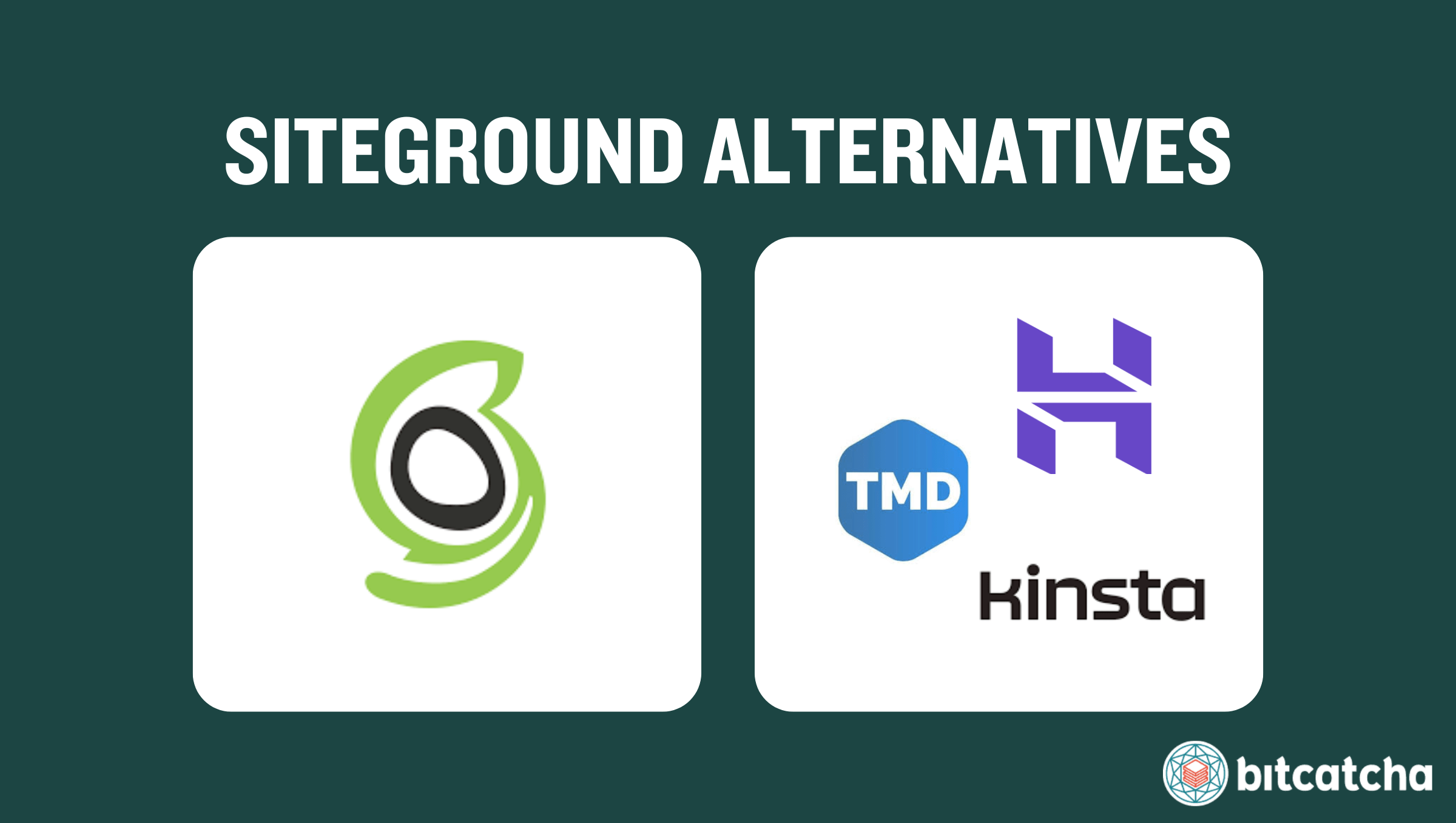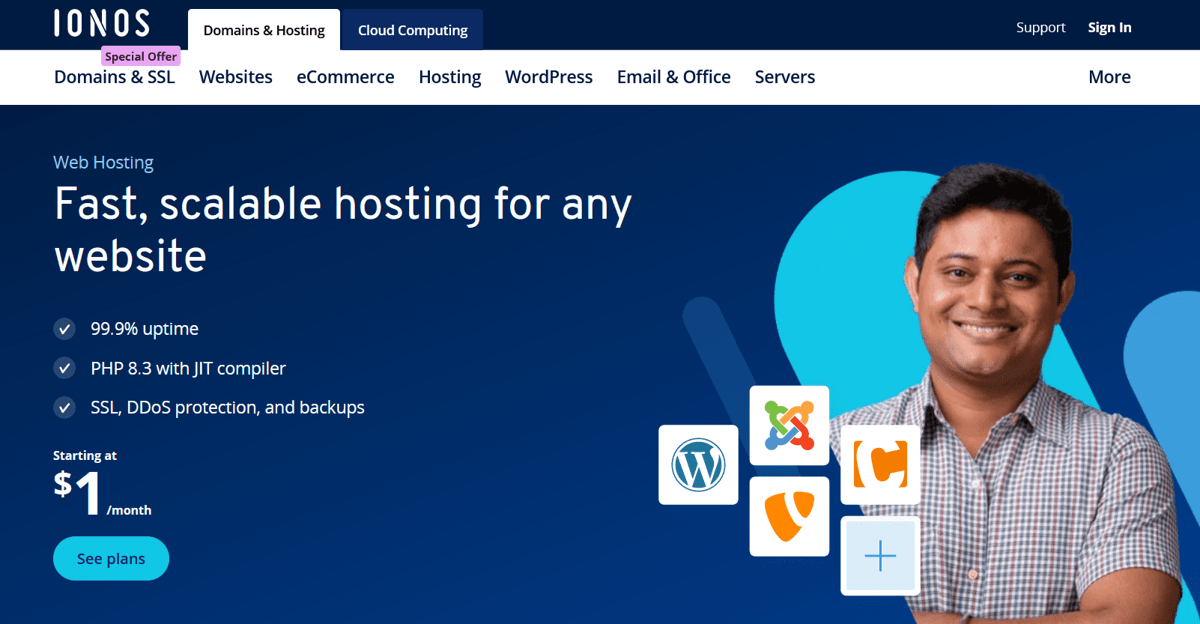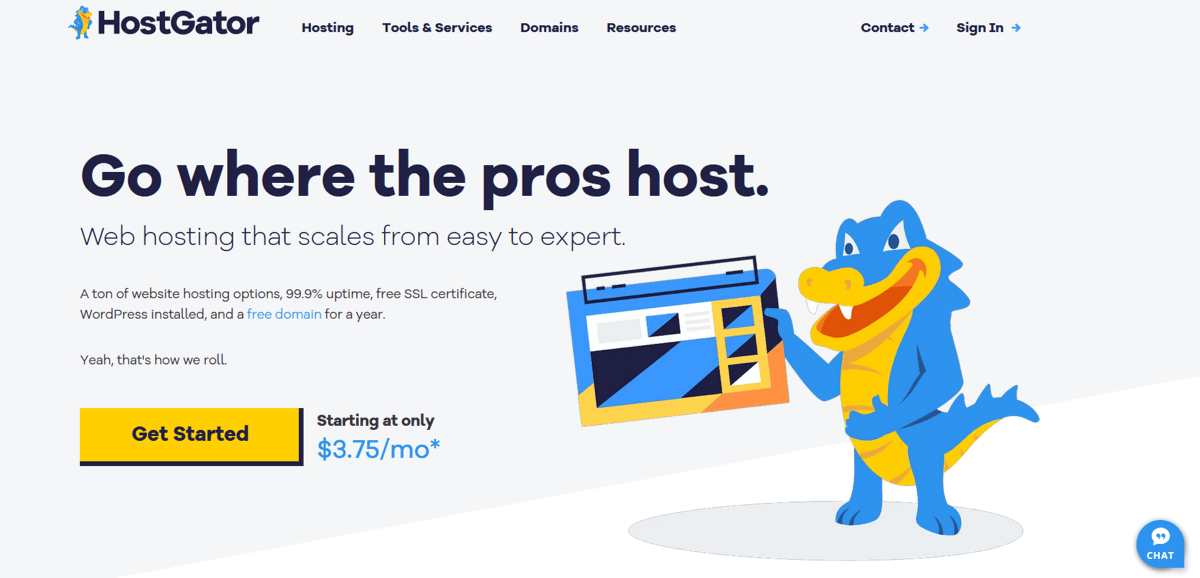SiteGround delivers reliable hosting and premium managed services. It runs on Google Cloud Platform infrastructure and uses proprietary SuperCacher technology to optimize performance. SiteGround targets users who want a fast and secure hosting experience backed by responsive support. However, SiteGround’s plans are more expensive in the long run and include strict resource limits on entry-level plans.
Alternatives to SiteGround refer to direct competitors that match or outperform it in areas such as lower introductory and renewal pricing, performance features, and data center coverage. When choosing the best Siteground alternatives, look for cheaper prices, faster performance, cloud hosting with higher storage, managed WordPress plans and strategic data center locations like Australia.
Hostinger, TMDHosting, and Kinsta are the best alternatives to SiteGround. Hostinger starts at $2.99/mo and offers value-packed plans. TMDHosting starts at $9.52/mo and offers 50 GB SSD storage, unlimited email, and LiteSpeed caching. Kinsta starts at $30/mo and runs on Google Cloud’s premium tier.
siteground alternatives


1. Hostinger
https://www.hostinger.com
Hostinger’s shared hosting plans start from a very affordable $2.99/month for a 48-month plan. This is on par with SiteGround’s $3.99 introductory pricing. However, Hostinger’s plans renew at $6.99/month, which is significantly cheaper than SiteGround’s $17.99 renewal rate.
Hostinger’s entry level plan provides 25 GB SSD storage, support for 25 websites and a free domain. SiteGround’s entry level plan only provides 10 GB storage, supports 1 website and does not include a free domain. Upgrading to Hostinger’s cloud hosting plans provides higher redundancy and resources. Their Cloud Startup provides 100 GB of fast NVMe storage, unlimited bandwidth, and support for 100 websites.
Hostinger operates 10 data centers in the US, UK, Netherlands, Lithuania, India, Singapore, Brazil, and Indonesia. This is plentiful, but offers less choice than SiteGround’s 11 data centers across the US, UK, Spain, Netherlands, Germany, France, Australia, and Singapore.
Hostinger’s servers are thoroughly optimized for speed. Hostinger uses LiteSpeed servers and LiteSpeed Cache. SiteGround runs on Google Cloud with NGINX and provides their SuperCacher plugin. Both hosts support WordPress well, but Hostinger delivers more storage, more site capacity, and much more affordable long-term pricing. Compare Hostinger and SiteGround directly in our writeup on SiteGround vs Hostinger.

2. TMDHosting
https://www.tmdhosting.com
TMDHosting starts at $9.52 a month for shared hosting. This is more expensive than SiteGround’s introductory pricing. However, TMDHosting renews at $11.99/month, which is considerably cheaper than SiteGround’s $17.99/month renewal.
TMDHosting’s starter plan provides 50 GB SSD storage, unlimited bandwidth, and unlimited email accounts. SiteGround’s StartUp plan only includes 10 GB of storage, 1 website, and fewer backend tools. TMDHosting also includes a free domain, unlike SiteGround.
TMDHosting operates 6 data centers across the US, Canada, UK, Germany, Singapore, and Australia. This is fewer than SiteGround’s network of 11 data centers.
Both TMDHosting and SiteGround offer fast servers and speed optimizing software. TMDHosting leverages LiteSpeed caching, fast CloudLinux servers, and full cPanel access. Compare TMDHosting and SiteGround directly in our writeup on SiteGround vs TMDHosting.

3. Kinsta
https://kinsta.com
Kinsta specializes in premium WordPress hosting. Kinsta plans start at a high price of $30/month but do not increase on renewal. SiteGround starts at $3.99/month but renews at $17.99/month. Kinsta costs more upfront than SiteGround, but offers predictable pricing in the long-term.
Kinsta’s Starter plan supports 1 website and provides 10 GB SSD storage. Kinsta also provides WordPress-specific features and access to a highly skilled team of WordPress experts. SiteGround’s StartUp plan offers similar limits (1 website, 10 GB), but includes fewer managed WordPress features. Kinsta excludes email hosting and domains, while SiteGround includes free email but not domains.
Kinsta operates wider server coverage than SiteGround. Kinsta provides access to 35 global data centers through Google Cloud’s premium tier, and lets you choose from locations in the US, Europe, Asia, and more. This provides significantly greater international coverage compared to SiteGround’s 11 data centers.
Kinsta runs on Google Cloud C2 machines and includes free Cloudflare Enterprise CDN, advanced DDoS protection, and proactive uptime monitoring. SiteGround also uses Google Cloud and includes SuperCacher, but lacks enterprise-level CDN. Compare Kinsta and SiteGround directly in our writeup on SiteGround vs Kinsta.

4. Cloudways
https://www.cloudways.com
Cloudways is another web host specializing in cloud hosting. Cloudways starts at $11/month and does not hike its prices upon renewal. SiteGround’s prices start lower at $3.99/month but renew at $17.99/month. This means Cloudways offers more consistent value for users. Cloudways also offers pay-as-you-go pricing plans that provide more billing flexibility.
Cloudways supports unlimited websites, 25 GB SSD storage, and 1 TB bandwidth on its DigitalOcean DO1GB plan. SiteGround’s StartUp plan only allows 1 website and 10 GB storage with unmetered bandwidth. Cloudways doesn’t include a free domain or email, while SiteGround includes free email.
Cloudways partners with top cloud providers to give its customers access to 65+ data centers. Server locations include the US, Germany, Italy, Australia, Korea and Singapore. SiteGround’s network of 11 locations is significantly smaller.
Cloudways uses fast NVMe SSD storage (on some providers), advanced caching (Varnish, Redis, Memcached), and an optional $5/month Cloudflare Enterprise CDN. SiteGround enhances speed by using SSD storage, a SuperCacher plugin, and standard CDN support. Cloudways offers greater flexibility, higher scalability, and broader server coverage for developers and growing sites compared to SiteGround. Compare Cloudways and SiteGround directly in our writeup on SiteGround vs Cloudways.

5. WP Engine
https://wpengine.com
WP Engine starts at $20/month and doesn’t raise prices on renewal. This makes both its introductory pricing and renewal pricing more expensive than SiteGround, but more predictable. However, WP Engine offers more value for WordPress-focused users by including proprietary WordPress tools and access to WordPress experts.
Both WP Engine and SiteGround limit their entry plans to 1 website and 10 GB SSD storage. WP Engine provides 50 GB bandwidth on its Startup plan while SiteGround offers unmetered bandwidth but lacks WordPress-specific resource scaling. WP Engine excludes email hosting, while SiteGround includes it. Both WP Engine and SiteGround do not provide free domains.
WP Engine runs on Google Cloud and gives access to 20+ global data center locations by request, compared to SiteGround’s 11 fixed locations. WP Engine also includes EverCache® for optimized WordPress performance and a built-in Cloudflare CDN. Overall, WP Engine costs more upfront but outperforms SiteGround on raw speed, WordPress-specific features, and global hosting flexibility. It’s better suited for serious WordPress users who want hands-off hosting and ultra-low latency across regions. Compare WP Engine and SiteGround directly in our writeup on WP Engine vs SiteGround.

6. IONOS
https://www.ionos.com
IONOS starts at $4/month and renews at $6/month. This makes IONOS more expensive than SiteGround to get started, but significantly cheaper than SiteGround upon renewal. Both IONOS and SiteGround only allow one website on their entry plans. However, IONOS provides 25 GB SSD storage and 50 GB bandwidth, compared to SiteGround’s 10 GB SSD and unmetered bandwidth. IONOS includes a free domain and one email account. SiteGround includes unlimited email but charges extra for domains.
IONOS runs on Xeon processors and SSD/NVMe storage with HTTP/2 and PHP 8.x support. SiteGround also uses SSDs and supports the latest PHP. However, IONOS stands out by offering 9 GB RAM and 1 vCPU even on its cheapest plan. IONOS’s Their higher-level plans provide enterprise-grade security and full root access. They uphold ISO-certified infrastructure and a 99.99% uptime SLA. IONOS operates 8 data centers across the United States (Nevada, New Jersey, Kansas) and Europe (Germany, France, UK, Spain). This is slightly less than SiteGround’s network of 11 data centers but IONOS gives solid coverage for North America and Europe. Compare IONOS and SiteGround directly in our writeup on SiteGround vs IONOS.

7. Hosting.com
https://hosting.com
Hosting.com (formerly A2 Hosting) starts at $1.99/month and renews at $10.29/month for their Starter plan. This is slightly above SiteGround’s $3.99 entry but still cheaper than its $17.99 renewal.
Hosting.com’s Turbo plan includes unlimited websites, unlimited storage, and unlimited bandwidth, whereas SiteGround’s StartUp plan supports 1 site and 10 GB SSD storage. You also get a free SSL, unlimited emails, and free site migration, which are benefits SiteGround either limits or charges extra for. However, hosting.com does not include a free domain.
Hosting.com’s Turbo plan clocked a global average of 149 ms, slightly faster than SiteGround’s 137 ms. Hosting.com uses Turbo servers, NVMe SSDs, LiteSpeed-compatible caching, and Hosting.com Optimized software for platforms like WordPress. SiteGround uses NGINX with its SuperCacher plugin, but Hosting.com offers broader caching options like OPcache and Memcached for advanced users.Hosting.com operates 4 global data centers: Michigan and Arizona (USA), Amsterdam (Netherlands), and Singapore. SiteGround covers more regions with 11 locations including the US, UK, Germany, France, Spain, Netherlands, Singapore, and Australia. SiteGround has the edge in geographic reach, but Hosting.com offers solid performance if your audience is in Asia or North America. Compare Hosting.com and SiteGround directly in our writeup on SiteGround vs Hosting.com.

8. DreamHost
https://www.dreamhost.com
DreamHost starts at $3.95/month and renews at $12.99/month for the Unlimited plan. That’s slightly more than SiteGround’s $3.99 intro, but still far cheaper than its $17.99 renewal.
DreamHost gives you unlimited SSD storage, unlimited bandwidth, and unlimited websites. SiteGround’s StartUp plan limits you to 1 site and 10 GB storage. DreamHost also includes a free domain, unlimited email accounts, free SSL, and daily backups. SiteGround charges extra for domains and limits free email to lower tiers.
DreamHost matches SiteGround’s performance in the U.S. They average 118 ms global response time from their U.S.-based data centers. SiteGround scores 137 ms globally, with faster edge delivery thanks to more locations. However, DreamHost guarantees 100% uptime, while SiteGround offers 99.99%. Both use SSD storage and WordPress optimization, but DreamHost has full WordPress integration and is officially recommended by WordPress.org (just like SiteGround).
DreamHost runs 2 data centers, both located in the United States (Virginia and Oregon). SiteGround operates 11, with locations across the U.S., Europe, Asia, and Australia. SiteGround has wider geographic coverage for global reach, while DreamHost delivers strong performance for U.S. focused sites and better long-term value. Compare DreamHost and SiteGround directly in our writeup on SiteGround vs DreamHost.

9. HostGator
https://www.hostgator.com
HostGator’s Hatchling plan starts at $3.75/month and renews at $9.99/month. This makes it cheaper than SiteGround’s $3.99 intro and $17.99 renewal in the long run.
HostGator’s Hatchling plan offers 10 GB SSD storage, supports up to 10 websites, and provides unmetered bandwidth. SiteGround’s StartUp plan supports just 1 website and caps storage at 10 GB. Both hosts include a free domain and SSL, but HostGator also includes unlimited email. SiteGround limits email usage at higher tiers. HostGator uses standard server optimization and lacks advanced speed features like NGINX or custom caching. Still, it maintains stable uptime with a 99.9% guarantee.
HostGator operates 2 data centers: one in Texas and one in Utah. This is extremely limited compared to SiteGround’s 11 data centers. SiteGround is stronger for international reach and faster edge speeds. HostGator is a good pick if your audience is US-based and you want unmetered bandwidth and affordable long-term pricing. Compare HostGator and SiteGround directly in our writeup on SiteGround vs HostGator.
Who Are the Siteground Alternatives for Different Hosting Needs?
SiteGround’s alternatives include Hostinger, IONOS, DreamHost, Kinsta, WP Engine, Hosting.com (A2 Hosting), and TMDHosting. Each offers better value than SiteGround across specific use cases such as lower pricing, faster server performance, larger cloud storage limits, fully managed WordPress hosting, or Australia-based data centers.
Which Web Hosts Are More Affordable Than SiteGround?
These web hosts are more affordable than SiteGround.
| Web Host | Plan | Introductory Cost (/mo) |
|---|---|---|
| SiteGround | StartUp | $3.99 |
| Hostinger | Premium | $2.99 |
| IONOS | Plus | $1.00 |
| DreamHost | Shared | $2.95 |
Which Web Hosts Are Faster Than SiteGround?
These hosts are faster than SiteGround, and include advanced performance features that outperform SiteGround’s stack.
| Web Host | Performance Features |
|---|---|
| SiteGround | Google Cloud Platform, SuperCacher |
| Hostinger | NVMe Storage, LiteSpeed |
| Kinsta | Google Cloud Platform, Edge Caching |
| Hosting.com | Turbo Servers, NVMe, LiteSpeed, HTTP/3 |
Which Web Hosts Provide More Storage Than SiteGround for Cloud Hosting?
Cloud hosting refers to a type of hosting that delivers scalable resources through a network of virtual servers. The web hosts below offer higher storage allocations than SiteGround in their entry-level cloud hosting plans.
| Web Host | Plan | Storage |
|---|---|---|
| SiteGround | Jump Start | 40 GB SSD |
| Hostinger | Cloud Startup | 100 GB NVMe |
| DreamHost | 512 RAM Server | 80 GB SSD |
| IONOS | Basic Cube XS | 60 GB SSD |
What Are the SiteGround Alternatives for Managed WordPress Hosting?
Managed WordPress hosting refers to a type of hosting where the provider handles WordPress updates, security, performance optimization, and support to simplify site management. These are the SiteGround alternatives for managed WordPress hosting.
| Web Host | Plan | Introductory Cost (/mo) |
|---|---|---|
| SiteGround | StartUp | $3.99 |
| Hostinger | Premium | $2.99 |
| Kinsta | Single 35K | $32 |
| WP Engine | Essential | $25 |
What Are the SiteGround Alternatives With Australia Data Centers?
These are the SiteGround alternatives with data centers in Australia.
| Web Host | Australia Data Center Location |
|---|---|
| SiteGround | Sydney |
| TMDHosting | Sydney |
| Kinsta | Melbourne, Sydney |
| WP Engine | Sydney |
